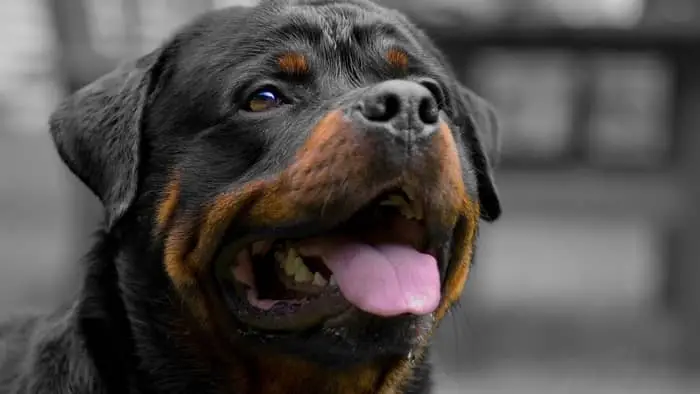Last Updated on April 24, 2024 by Dr. Julie
You can find most dog breeds with many coat colors, and an all-black German Rottweiler is a very popular option. Rottweilers aren’t the only species that come in an all-black coating. German Shepherds, Dobermans, and other large breeds are also very common with an all-black coat.
In today’s article, we’ll be taking a look at the many options you have regarding color when you’re choosing a Rottweiler and different physical aspects with Rottweilers!
Table of Contents
Solid Black Rottweiler
Rottweilers are very special and easily recognizable because of the tan spots on their black coat. However, some breeders only breed pure black Rottweilers. These dogs are very difficult to find, believe it or not, and there are several reasons for it. Even though they’re popular amongst owners, they’re not that popular with kennel clubs. According to breed standards, a Rottweiler must have tan spots.
So, if you’re looking to take your dog to dog shows – you can’t buy a Rottweiler that’s all black!
Given that many owners want to take their Rotties to dog shows, buying a completely black Rottweiler isn’t an option. Because of this, most breeders stopped breeding and trying to popularize these dogs. The lack of tan spots is seen as a foul when it comes to breeding standards!
This makes these dogs hard to find, which in turn makes them expensive. Some people, however, see all-black Rottweilers as great specimens and want to get one. Despite this being good news for dog breeders who happen to breed black Rottweilers, some vets and canine experts agree that breeders shouldn’t breed all-black Rottweilers – here’s why.
Why are these Rottweilers all black?
The reason some Rottweilers don’t develop tan spots is because of a genetic mutation. Therefore, in order for a breeder to create a whole litter of all-black Rottweilers, they have to find another Rottweiler with the same genetic mutation. Since these dogs are so rare, it’s not uncommon for the mother and the father to be related.
Inbreeding amongst dogs is not good, to put it plainly. Additionally, dogs that are prone to simple genetic mutations (such as having a completely black coat instead of black and tan) are also prone to other, possibly more dangerous genetic mutations. Because of these, even though these dogs are just as lovable as a regular Rottweiler, they potentially pose a health threat to themselves.
Color And Other Coat Variations
Being all-black isn’t the only variation of a Rottweiler’s look. There are many other genetic mutations that have different effects on the way a Rottweiler will look.

Long-haired Rottweiler
Believe it or not, Rottweilers can have long hair. Typically, we know that Rottweilers have a double layer of fur with short hair. This coat keeps them very warm during the winter. It is, however, possible for a Rottweiler to have long hair. Just like all the other entries on this list, these dogs won’t compete in dog shows as they’re not up to breed standards.
Their long hair, however, only makes them look more lovable. On the other hand, that same long hair will make shedding a nightmare for the owner!
Red Rottweilers
When it comes to coat alternatives, one could argue that red Rottweilers are the most popular of all the variations. Their coats are almost completely copper-brown, bordering with red, with very little or no black spots. Aside from that, there are no differences to your everyday Rottweiler. They still can’t enter competitions, though.
Albino Rottweilers
The difference in pigmentation that causes an animal to be albino can also occur with Rottweilers. This is, however, very rare. These Rottweilers are almost white with pink eyes.
You’re much more likely going to come across a grey Rottweiler. Even though they’re often dubbed “blue Rottweilers”, their coat is actually grey.
Black and mahogany, tan, rust
When it comes to the color variations that the AKC actually allows on their dog shows, black can be mixed with mahogany, tan, and rust. From these three, mahogany is the most common companion to black. Most people can’t tell the difference between the three, but mahogany is usually the darkest, with rust being much lighter. Tan, however, is the lighter out of these three and it provides the strongest contrast to the color black.
Caring For Your Rottweiler’s Coat
While we’re on the topic of coats, let’s take a look at the best routine experts to recommend to keep your dog’s coat healthy!
You should definitely bathe your Rottweiler, but the frequency depends on your dog’s activity. If you take your dog running every day, then you should bathe it once every other week. If the level of activity isn’t that high, then you can bathe it once every other month. This will prove to be especially helpful with shedding, as you’ll take off most of the hair in the bath!
These dogs don’t need too much grooming, as their hair is short, so make sure to brush them and bathe them every so often.
Something that’s incredibly important for your dog’s coat is its diet. If you introduce a healthy diet with the appropriate amounts of vitamins and minerals, your dog’s hair will show that off. This isn’t the only health-related tip, as you should also protect your dog from pests.
Fleas, parasites, ticks, mites, etc. – all of these pests will affect your dog’s health and the look of their coat, in return. Repelling them with a collar or shampoo might be the best choice.
To Sum Up
All-black Rottweilers are available, but they’re not easy to find. These dogs are essential carriers of genetic mutations, which is why most breeders keep away from breeding them. They also can’t compete in dog shows as their coat is not up to standard!
Additionally, we have red, albino, and blue (grey) Rottweilers. It’s also possible to find Rotties with long hair. The colors that are accepted are black with mahogany, tan, or rust.
If you try hard enough, you can surely find all-black Rottweilers for sale, but they might be expensive.
